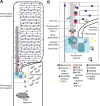Retinal disease in ciliopathies: Recent advances with a focus on stem cell-based therapies
- PMID: 31763178
- PMCID: PMC6839492
- DOI: 10.3233/TRD-190038
Retinal disease in ciliopathies: Recent advances with a focus on stem cell-based therapies
Abstract
Ciliopathies display extensive genetic and clinical heterogeneity, varying in severity, age of onset, disease progression and organ systems affected. Retinal involvement, as demonstrated by photoreceptor dysfunction or death, is a highly penetrant phenotype among a vast majority of ciliopathies. Photoreceptor cells possess a specialized and modified sensory cilium with membrane discs where efficient photon capture and ensuing signaling cascade initiate the visual process. Disruptions of cilia biogenesis and protein transport lead to impairment of photoreceptor function and eventually degeneration. Despite advances in elucidation of ciliogenesis and photoreceptor cilia defects, we have limited understanding of pathogenic mechanisms underlying retinal phenotype(s) observed in human ciliopathies. Patient-derived induced pluripotent stem cell (iPSC)-based approaches offer a unique opportunity to complement studies with model organisms and examine cilia disease relevant to humans. Three-dimensional retinal organoids from iPSC lines feature laminated cytoarchitecture, apical-basal polarity and emergence of a ciliary structure, thereby permitting pathogenic modeling of human photoreceptors in vitro. Here, we review the biology of photoreceptor cilia and associated defects and discuss recent progress in evolving treatment modalities, especially using patient-derived iPSCs, for retinal ciliopathies.
Keywords: Photoreceptor cilium; cell replacement; drug discovery; gene therapy; iPSC; organoid culture; retinal neurodegeneration; translational therapeutics.
© 2019 – IOS Press and the authors. All rights reserved.
Figures



Similar articles
-
Reserpine maintains photoreceptor survival in retinal ciliopathy by resolving proteostasis imbalance and ciliogenesis defects.Elife. 2023 Mar 28;12:e83205. doi: 10.7554/eLife.83205. Elife. 2023. PMID: 36975211 Free PMC article.
-
Primary cilia biogenesis and associated retinal ciliopathies.Semin Cell Dev Biol. 2021 Feb;110:70-88. doi: 10.1016/j.semcdb.2020.07.013. Epub 2020 Jul 31. Semin Cell Dev Biol. 2021. PMID: 32747192 Free PMC article. Review.
-
Photoreceptor sensory cilia and ciliopathies: focus on CEP290, RPGR and their interacting proteins.Cilia. 2012 Dec 3;1(1):22. doi: 10.1186/2046-2530-1-22. Cilia. 2012. PMID: 23351659 Free PMC article.
-
Retinal Ciliopathies and Potential Gene Therapies: A Focus on Human iPSC-Derived Organoid Models.Int J Mol Sci. 2024 Mar 1;25(5):2887. doi: 10.3390/ijms25052887. Int J Mol Sci. 2024. PMID: 38474133 Free PMC article. Review.
-
Patient stem cell-derived in vitro disease models for developing novel therapies of retinal ciliopathies.Curr Top Dev Biol. 2023;155:127-163. doi: 10.1016/bs.ctdb.2023.09.003. Epub 2023 Nov 4. Curr Top Dev Biol. 2023. PMID: 38043950 Free PMC article. Review.
Cited by
-
The inner junction protein CFAP20 functions in motile and non-motile cilia and is critical for vision.Nat Commun. 2022 Nov 3;13(1):6595. doi: 10.1038/s41467-022-33820-w. Nat Commun. 2022. PMID: 36329026 Free PMC article.
-
Genetic and Clinical Analyses of the KIZ-c.226C>T Variant Resulting in a Dual Mutational Mechanism.Genes (Basel). 2024 Jun 18;15(6):804. doi: 10.3390/genes15060804. Genes (Basel). 2024. PMID: 38927740 Free PMC article.
-
Human asthenozoospermia: Update on genetic causes, patient management, and clinical strategies.Andrology. 2025 Jul;13(5):1044-1064. doi: 10.1111/andr.13828. Epub 2025 Jan 2. Andrology. 2025. PMID: 39748639 Free PMC article. Review.
-
2-IPMA Ameliorates PM2.5-Induced Inflammation by Promoting Primary Ciliogenesis in RPE Cells.Molecules. 2021 Sep 6;26(17):5409. doi: 10.3390/molecules26175409. Molecules. 2021. PMID: 34500843 Free PMC article.
-
Retinal Degeneration Animal Models in Bardet-Biedl Syndrome and Related Ciliopathies.Cold Spring Harb Perspect Med. 2023 Jan 3;13(1):a041303. doi: 10.1101/cshperspect.a041303. Cold Spring Harb Perspect Med. 2023. PMID: 36596648 Free PMC article. Review.
References
-
- Rosenbaum J.L. and Witman G.B., Intraflagellar transport, Nat Rev Mol Cell Biol 3(11) (2002), 813–825. - PubMed
LinkOut - more resources
Full Text Sources
